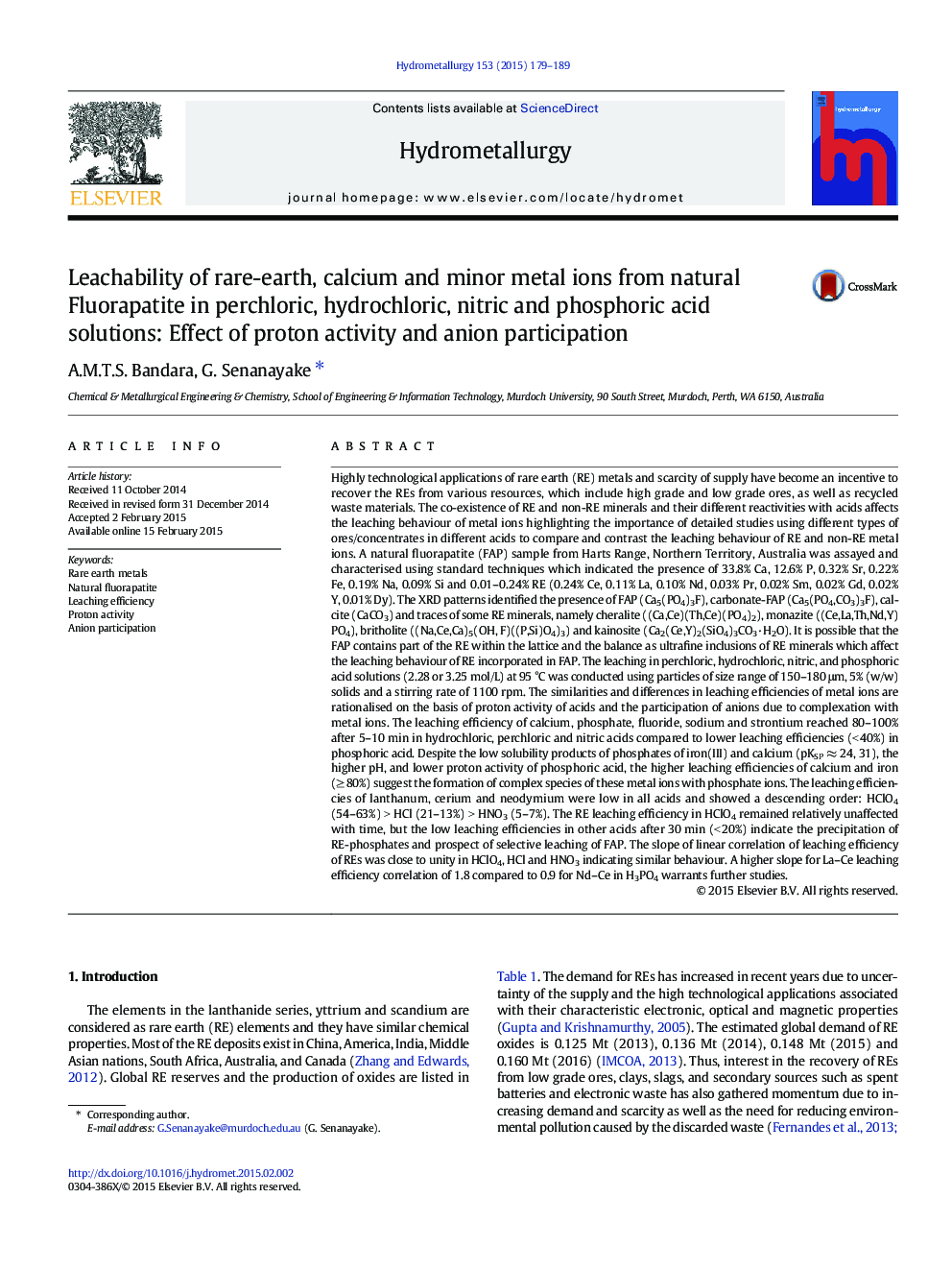| کد مقاله | کد نشریه | سال انتشار | مقاله انگلیسی | نسخه تمام متن |
|---|---|---|---|---|
| 212056 | 462031 | 2015 | 11 صفحه PDF | دانلود رایگان |
• High proton activity and anion participation facilitate cation leaching.
• Interaction with chloride and phosphate affects calcium and RE leaching.
• RE metal ions precipitate during prolonged leaching in H3PO4
• La–Ce and Nd–Ce leaching efficiency correlations have a slope ≈ 1
• Precipitation of RE in phosphoric acid during prolonged leaching facilitates selective leaching of calcium and minor metal ions.
Highly technological applications of rare earth (RE) metals and scarcity of supply have become an incentive to recover the REs from various resources, which include high grade and low grade ores, as well as recycled waste materials. The co-existence of RE and non-RE minerals and their different reactivities with acids affects the leaching behaviour of metal ions highlighting the importance of detailed studies using different types of ores/concentrates in different acids to compare and contrast the leaching behaviour of RE and non-RE metal ions. A natural fluorapatite (FAP) sample from Harts Range, Northern Territory, Australia was assayed and characterised using standard techniques which indicated the presence of 33.8% Ca, 12.6% P, 0.32% Sr, 0.22% Fe, 0.19% Na, 0.09% Si and 0.01–0.24% RE (0.24% Ce, 0.11% La, 0.10% Nd, 0.03% Pr, 0.02% Sm, 0.02% Gd, 0.02% Y, 0.01% Dy). The XRD patterns identified the presence of FAP (Ca5(PO4)3F), carbonate-FAP (Ca5(PO4,CO3)3F), calcite (CaCO3) and traces of some RE minerals, namely cheralite ((Ca,Ce)(Th,Ce)(PO4)2), monazite ((Ce,La,Th,Nd,Y)PO4), britholite ((Na,Ce,Ca)5(OH, F)((P,Si)O4)3) and kainosite (Ca2(Ce,Y)2(SiO4)3CO3·H2O). It is possible that the FAP contains part of the RE within the lattice and the balance as ultrafine inclusions of RE minerals which affect the leaching behaviour of RE incorporated in FAP. The leaching in perchloric, hydrochloric, nitric, and phosphoric acid solutions (2.28 or 3.25 mol/L) at 95 °C was conducted using particles of size range of 150–180 μm, 5% (w/w) solids and a stirring rate of 1100 rpm. The similarities and differences in leaching efficiencies of metal ions are rationalised on the basis of proton activity of acids and the participation of anions due to complexation with metal ions. The leaching efficiency of calcium, phosphate, fluoride, sodium and strontium reached 80–100% after 5–10 min in hydrochloric, perchloric and nitric acids compared to lower leaching efficiencies (< 40%) in phosphoric acid. Despite the low solubility products of phosphates of iron(III) and calcium (pKSP ≈ 24, 31), the higher pH, and lower proton activity of phosphoric acid, the higher leaching efficiencies of calcium and iron (≥ 80%) suggest the formation of complex species of these metal ions with phosphate ions. The leaching efficiencies of lanthanum, cerium and neodymium were low in all acids and showed a descending order: HClO4 (54–63%) > HCl (21–13%) > HNO3 (5–7%). The RE leaching efficiency in HClO4 remained relatively unaffected with time, but the low leaching efficiencies in other acids after 30 min (< 20%) indicate the precipitation of RE-phosphates and prospect of selective leaching of FAP. The slope of linear correlation of leaching efficiency of REs was close to unity in HClO4, HCl and HNO3 indicating similar behaviour. A higher slope for La–Ce leaching efficiency correlation of 1.8 compared to 0.9 for Nd–Ce in H3PO4 warrants further studies.
Journal: Hydrometallurgy - Volume 153, March 2015, Pages 179–189
